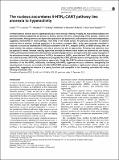| dc.contributor.author | Jean, A. | |
| dc.contributor.author | Laurent, L. | |
| dc.contributor.author | Bockaert, J. | |
| dc.contributor.author | Charnay, Y. | |
| dc.contributor.author | Dusticier, N. | |
| dc.contributor.author | Nieoullon, A. | |
| dc.contributor.author | Barrot, M. | |
| dc.contributor.author | Neve, Rachael L. | |
| dc.contributor.author | Compan, V. | |
| dc.date.accessioned | 2014-07-09T15:58:33Z | |
| dc.date.available | 2014-07-09T15:58:33Z | |
| dc.date.issued | 2012-12 | |
| dc.date.submitted | 2012-10 | |
| dc.identifier.issn | 2158-3188 | |
| dc.identifier.uri | http://hdl.handle.net/1721.1/88235 | |
| dc.description.abstract | In mental diseases, the brain does not systematically adjust motor activity to feeding. Probably, the most outlined example is the association between hyperactivity and anorexia in Anorexia nervosa. The neural underpinnings of this ‘paradox’, however, are poorly elucidated. Although anorexia and hyperactivity prevail over self-preservation, both symptoms rarely exist independently, suggesting commonalities in neural pathways, most likely in the reward system. We previously discovered an addictive molecular facet of anorexia, involving production, in the nucleus accumbens (NAc), of the same transcripts stimulated in response to cocaine and amphetamine (CART) upon stimulation of the 5-HT4 receptors (5-HTR4) or MDMA (ecstasy). Here, we tested whether this pathway predisposes not only to anorexia but also to hyperactivity. Following food restriction, mice are expected to overeat. However, selecting hyperactive and addiction-related animal models, we observed that mice lacking 5-HTR1B self-imposed food restriction after deprivation and still displayed anorexia and hyperactivity after ecstasy. Decryption of the mechanisms showed a gain-of-function of 5-HTR4 in the absence of 5-HTR1B, associated with CART surplus in the NAc and not in other brain areas. NAc-5-HTR4 overexpression upregulated NAc-CART, provoked anorexia and hyperactivity. NAc-5-HTR4 knockdown or blockade reduced ecstasy-induced hyperactivity. Finally, NAc-CART knockdown suppressed hyperactivity upon stimulation of the NAc-5-HTR4. Additionally, inactivating NAc-5-HTR4 suppressed ecstasy’s preference, strengthening the rewarding facet of anorexia. In conclusion, the NAc-5-HTR4/CART pathway establishes a ‘tight-junction’ between anorexia and hyperactivity, suggesting the existence of a primary functional unit susceptible to limit overeating associated with resting following homeostasis rules. | en_US |
| dc.description.sponsorship | France. Agence nationale de la recherche (ANR-MNP 2009, SERFEED) | en_US |
| dc.language.iso | en_US | |
| dc.publisher | Nature Publishing Group | en_US |
| dc.relation.isversionof | http://dx.doi.org/10.1038/tp.2012.131 | en_US |
| dc.rights | Creative Commons Attribution-NonCommercial-NoDerivs 3.0 | en_US |
| dc.rights.uri | http://creativecommons.org/licenses/by-nc-nd/3.0/ | en_US |
| dc.source | Nature Publishing Group | en_US |
| dc.title | The nucleus accumbens 5-HTR4-CART pathway ties anorexia to hyperactivity | en_US |
| dc.type | Article | en_US |
| dc.identifier.citation | Jean, A, L Laurent, J Bockaert, Y Charnay, N Dusticier, A Nieoullon, M Barrot, R Neve, and V Compan. “The Nucleus Accumbens 5-HTR4-CART Pathway Ties Anorexia to Hyperactivity.” Translational Psychiatry 2, no. 12 (December 2012): e203. | en_US |
| dc.contributor.department | Massachusetts Institute of Technology. Department of Brain and Cognitive Sciences | en_US |
| dc.contributor.mitauthor | Neve, Rachael L. | en_US |
| dc.relation.journal | Translational Psychiatry | en_US |
| dc.eprint.version | Final published version | en_US |
| dc.type.uri | http://purl.org/eprint/type/JournalArticle | en_US |
| eprint.status | http://purl.org/eprint/status/PeerReviewed | en_US |
| dspace.orderedauthors | Jean, A; Laurent, L; Bockaert, J; Charnay, Y; Dusticier, N; Nieoullon, A; Barrot, M; Neve, R; Compan, V | en_US |
| dc.identifier.orcid | https://orcid.org/0000-0002-3854-5968 | |
| mit.license | PUBLISHER_CC | en_US |
| mit.metadata.status | Complete | |
